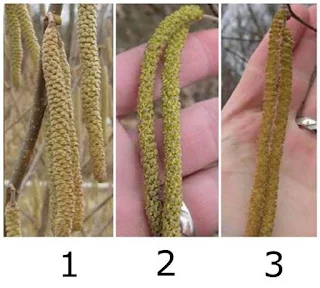 | |
| This is a gallon bag with nuts from Larry Sibley's seedling that survived the EFB. |
 |
| Larry's seedling on the left and Grand Traverse on the right in all pictures. |
The amazing thing is that some years he has good pollination. This was not one of those years. The trees looked fine but the nuts were few and far between.
Hoping to help out my friend Larry, I sent an email to Dr Thomas Molnar. Dr Molnar is a filbert breeder at Rutgers University in New Jersey. I asked him if he had any recommendations for pollinators for Grand Traverse.
Dr Molnar answered my questions and sent me a copy of a paper on filbert pollination. While looking at the paper I noticed that the authors of the paper are masters of compressing large amounts of information into compact, easy-to-read charts. I want to share what I saw and try to explain why these charts are so cool.
The pictures
These are pictures of the catkins. Catkins are the pollen producing organs. Stage 2 is the prime, pollen shedding stage with 1 being early and 3 being spent. In real life the color differences between the stages are more pronounced than shown in the photos. I suspect these pictures were taken on a cloudy day.
These are pictures of the pistils. Pistils are the female reproductive organs...sex pistils if you enjoy a little bit of botanical humor. Stage 3 is the most receptive stage. The feathery, red pistils turn brown when they are old and no longer fertile.
This chart contains a massive amount of information but is much easier to read than it looks.
This is the line for the variety Grand Traverse. The timing for the stages of the female parts is shown in the top bar and the colors correspond to the colors of the buds and the feathery pistils. The region circled in red denotes the prime receptivity. The timing for the stages of the male parts is shown in the lower bar and the colors correspond to the colors of the catkin as it matures. The region circled in yellow denotes prime pollen shed.
Finding a good pollinator for Grand Traverse involves finding cultivars that have peak shedding period slightly before, during and slightly after Grand Traverse's peak female receptivity.
 |
| The black arrow pointing in from the left side identifies the pistillate timing for the cultivar 'Grand Traverse'. |
To summarize what is cool about this chart is the amount of information that is embedded within it and the author's use of color schemes that intuitively link the information captured in the chart to the biological realities of the filbert plant: Pollen is yellow and pistils are red.






When is the time to gather wild hazelnuts?
ReplyDelete